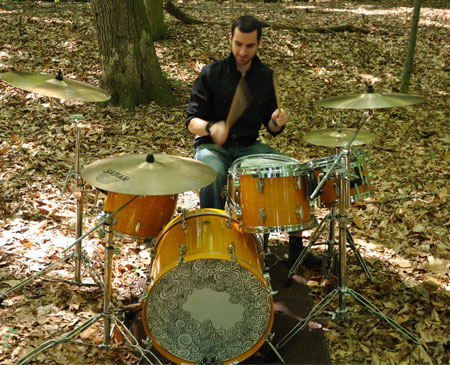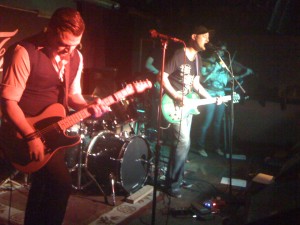
Playing drums is a physical challenge. The longer you play the greater the probability of developing a repetitive-strain related condition (RSI) or carpel tunnel syndrome (CTS) symptoms. These types of injuries are also called “overuse injuries” because they are the result of repetitive use and stress to the soft tissues (muscles, nerves, fascia, tendons and ligaments etc.) of the body without allowing proper time for recovery. Sometimes an acute injury (injury related to a single event) can lead to a RSI condition. These conditions are really stressful because they linger on and can wreck havoc on us mentally. Since I’ve been dealing with these conditions for the past decade, I’d like to share some insights on what I’ve learned over the years.
1. Rest and Ice Your Body
RICE is an acronym for Rest, Ice, Compression, and Elevation. It’s the go-to first aid treatment for acute-soft tissue injuries. However, for overuse injuries rest and ice can help the most. If you’re on tour, work towards keeping your days as restful as possible. Engage in low impact activities such as swimming, walking, and stretching. After the performance, ice the overused areas of the body such as the hands, wrists, and shoulders.
2. Play with Good Drumming Technique
If you haven’t yet studied the Moeller method, now would be a good time to get into it. Although the Moeller technique won’t cure an overuse issue on the spot, it’s great for preventing these types of injuries, as well as your overall playing. I recommend Jim Chapin’s DVD entitled Jim Chapin: Speed, Power, Control, Endurance. I also recommend switching to a thicker stick which can make it easier to play utilizing a looser and wider grip. If you’re playing any heavy style of music I recommend a thick stick like Vic Firth’s 5Bs. Also check out the SD10 Swinger drum sticks which have a nice thickness to them but are a lighter weight than the 5B.
3. Coordinate Your Body Movement
I started taking Alexander Technique lessons in 2008. It’s great for any musician but I think it’s especially helpful for drummers. Basically, this movement technique helps you become truly aware of your body habits and can reduce your tension areas. The bulk of the work involves reeducating yourself to move and perform activities with coordination and ease. The Alexander Technique also helps release tension while you are sitting, standing, or lying on the floor. You can practice this technique along with drumming (it goes very well with Moeller technique) as well as incorporate it into everything you do. Private lessons with a certified teacher are the best way to get started; however, group classes can be more affordable and are popular for beginners.
4. Practice Yoga
I started practicing yoga shortly after I was diagnosed with CTS. After two months, the tingling and numbness in my hands disappeared. If you haven’t done yoga, I recommend finding a beginner level Iyengar class. Iyengar is a form of Hatha yoga that focuses on structural alignment along with the breath. If an Iyengar class isn’t accessible than find a traditional Hatha class that focuses on self-awareness (opposed to physical fitness). If you go to a class while having a CTS flare up, it’s best to modify some of the poses. Make sure to tell the instructor before the class starts what you are dealing with. Check out this yoga journal article about healing CTS.
5. Get Adequate Sleep
Many of us don’t get enough sleep. Unfortunately, lack of sleep is one of the major causes for repetitive injuries. Sleep helps the body repair tissues and rejuvenates the nervous system. Get to know your body and how much sleep it needs for you to have a full tank of gas before you start your day. The quality of your sleep is just as important. I’d rather get six hours of uninterrupted sleep than nine hours of turbulence. I found that good quality sleep is vital to managing any stress related condition.
6. Build Muscular Support
Once you’ve allowed yourself enough rest and low impact activities, it’s time to bring on the weights. It’s important to build some muscle support surrounding the chronically injured area. This helps circulation in the weakened area. The stronger muscles thus help support the whole area. However, it’s a balance and the trick is not to overdo it. Ease into it. Start with very light weights, low reps, and be attentive to your form and movement.
7. Stretch Before You Play
It’s common sense to always stretch before doing any strenuous activities. However, sometimes we forget–once we see drums our primal instincts take over and we are too excited to do anything except make noise. The good news is we don’t have to stretch immediately before playing to gain the benefits. I like to stretch at least an hour before a gig and then focus on keeping loose and warm right up to show time. I do a combination of yoga and hand stretches–getting into the stretch details would entail a separate post. For now, check out this samba drummer’s stretches if you need a few ideas: http://www.puppetista.org/drums/stretch.html
8. Integrate Supplements
There are many supplements that can help with CTS and RSI. I’ve researched and tried many supplements that are reported to help with either inflammation, neuropathy or both. Here’s what I’m currently taking:
-
- NAC (N-Acetyl L-Cysteine)
– NAC has been reported to help with peripheral nerve dysfunction (CTS)
- Vitamin B12 Sublingual Liquid Drops
– B12 reported to help with nerve conditions (CTS)
- R-Alpha Lipoic Acid
– ALA has been reported to improve neuropathy symptoms and impairment (CTS)
- MSM
– MSM reported to help with arthritis, pain, and joint movement (RSI)
- Turmeric
– Reported to reduce inflammation and pain (CTS, RSI)
- Omega 3 Fish Oil
– Reported to help with inflammation (CTS, RSI)
- NAC (N-Acetyl L-Cysteine)
There is a ton of information regarding all these supplements and their potential benefits and side effects. You can also find research papers from the NCBI regarding most of these supplements. In addition to your own research I recommend working with a professional doctor or healthcare professional that is familiar with integrative supplementation.
9. Eat Whole Foods That Can Reduce Inflammation and Avoid Nightshades
Since both CTS and RSI symptoms are caused by inflammation it makes sense to eat foods that can give you anti-inflammatory benefits (and stay away from foods that cause inflammation). Eating whole foods while avoiding anything processed is a great start. If you’re on tour, choose a supermarket over any type of fast food restaurant. If you have concerns about telling your band mates why you can’t eat at McDonald’s, (believe me I’ve been there) simply mention that you need full control over what you put into your body.
It’s taking me a while to change my diet but the results have certainly been worth it. I’ve slowly added more raw foods into my diet while reducing dairy and most forms of gluten. I also like to add whole foods and herbs that are well known to reduce inflammation. Avocado, ginger, basil, and willow bark have worked very well for me.
Dr. Linda Mundorff recommends reducing the consumption of alkaloid-containing fruits, vegetables, and spices (many in the nightshade family of plants) that may trigger inflammatory-related joint problems.
-
-
- Tomatoes
- White potatoes
- Eggplant
- Sweet and hot peppers
- Pimentos
- Paprika
- Cayenne pepper
-
10. Be Patient
Although I’m mentioning it last, it’s probably the most important tip in beating any lingering or repetitive injury. These type of injuries can be mentally draining because of the length of time they effect you. We get used to our bodies healing in a certain time frame. I was freaking out after six months of dealing with my right shoulder tendonitis. I started doubting my technique as well as my body’s ability to heal. It wasn’t until I accepted the condition and made a long term commitment to heal that I started making progress.

